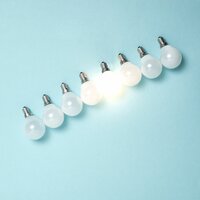Account
You are currently not logged in.
Login Forgot password?LED lighting has become increasingly popular in recent years. It is energy-efficient, lasts longer, and offers more lighting possibilities. However, LED bulbs are often more expensive than traditional lighting options like incandescent or halogen bulbs. In this blog, we will dive into the question: why are LED bulbs often more expensive?
The price of LED lighting can vary significantly. This is due to several factors that influence the cost. The main reasons for price differences include the quality of the LED technology, the brand, the lamp’s design, and the additional features that a bulb might offer.
Quality of LED Technology
The technology behind LED lighting is still relatively young and evolving rapidly. High-quality LED chips, which are the heart of the bulb, can be more expensive. These chips ensure better light quality, a longer lifespan, and higher energy efficiency. Cheaper LED bulbs may use less advanced technology, which can reduce their price, but it might compromise the bulb’s performance and lifespan.
Brand and Warranty
As with many other products, the price of LED bulbs can vary depending on the brand. Well-known brands often invest more in quality control, innovation, and customer service, which increases the price. Additionally, reputable brands usually offer longer warranties, which also contribute to the higher price. A bulb from a lesser-known brand might be cheaper but could have a shorter lifespan or less reliable performance.
Design and Extra Features
LED lighting is no longer just for basic illumination; in today’s world, it also comes with many additional features. Smart LED bulbs that can be controlled via an app, lights with adjustable colors, or motion-sensor bulbs are more expensive due to the technology and design involved. These extra features increase production costs and thus the final price of the bulb.
Quantity and Packaging
Sometimes, the price per bulb decreases when buying in bulk. Packaging and marketing also play a role in pricing. This explains why there can be a noticeable price difference between individual LED bulbs and those sold in sets or large quantities.
One of the biggest advantages of LED lighting is its energy efficiency. Compared to traditional incandescent and halogen bulbs, LED bulbs use much less energy to produce the same amount of light. This not only saves on electricity costs but also contributes to a more sustainable lifestyle.
Lower Energy Consumption
LED bulbs use up to 80% less energy than traditional incandescent bulbs. This is because LED lighting converts electricity much more efficiently into light rather than heat. For example, an incandescent bulb loses a large portion of energy as heat, while an LED bulb uses most of the energy to produce light. Halogen bulbs also consume a lot of energy to achieve the same brightness as an LED bulb, which means that LED lighting is ultimately cheaper in the long run.
Lower Electricity Costs
Although the initial cost of LED bulbs may be higher, you will save significantly on electricity bills in the long term. LED bulbs require fewer watts to produce the same amount of light, which means they use less power. This makes them ideal for long-term use in homes, offices, or public spaces. Due to their lower energy requirements, LED bulbs help reduce monthly energy costs.
Longer Lifespan and Fewer Replacements
Another advantage of LED bulbs is their long lifespan. While a traditional incandescent bulb might burn out after 1,000 hours of use, an LED bulb can last between 25,000 to 50,000 hours. This means fewer replacements, saving you both time and money. While the initial price of LED bulbs is higher, you will offset this cost through their longer lifespan and lower replacement needs.
Environmental Impact
Because of their energy efficiency and long lifespan, LED bulbs have a lower environmental impact compared to traditional lighting. They consume less energy, resulting in lower carbon emissions and other harmful gases. Additionally, LED bulbs do not contain harmful substances like mercury, which can be found in some other types of lighting. This makes LED lighting a much greener choice.
Although LED bulbs are often more expensive than traditional lighting, the higher cost is justified by the numerous benefits they offer. The price differences are influenced by factors such as technology, brand, design, and extra features. Moreover, LED bulbs are energy-efficient, meaning they save you money on electricity bills over the long term. With their long lifespan and low energy consumption, LED bulbs are both financially and environmentally advantageous. In the end, the lower energy costs and fewer replacements more than compensate for the higher initial price. It’s an investment that pays off quickly.
No comments found.
